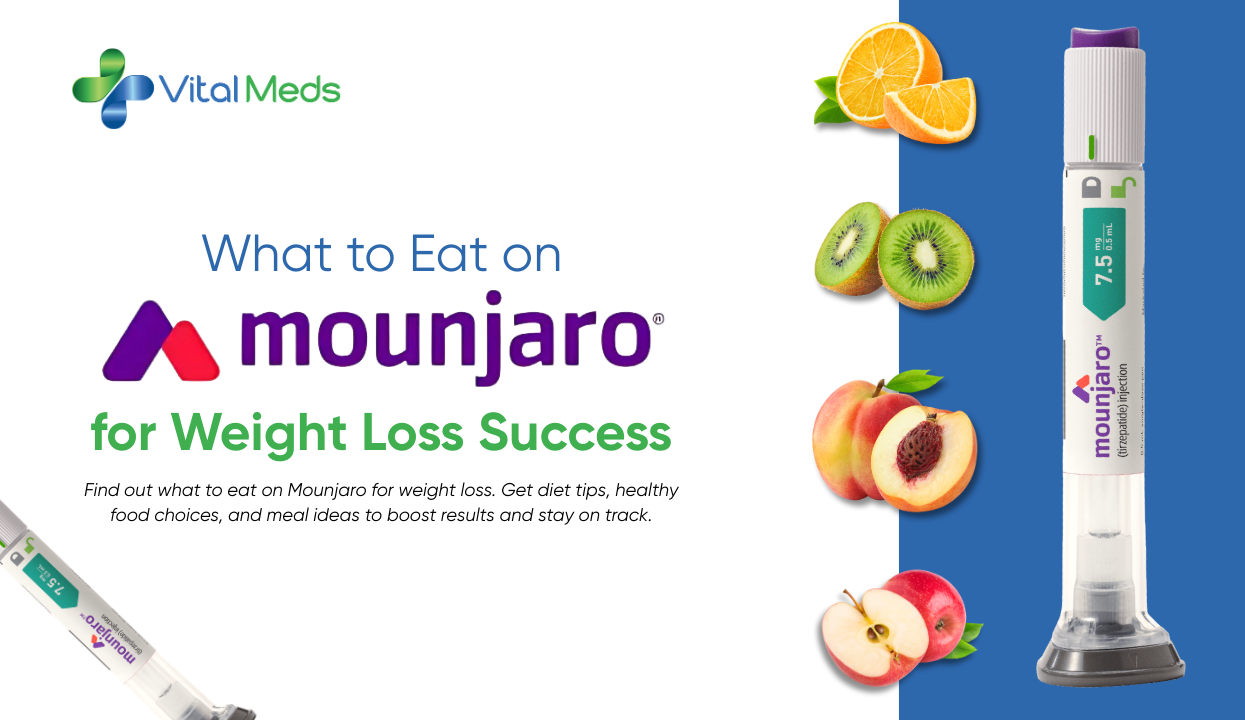- Your cart is empty
- Continue Shopping
Best Foods to Eat on Mounjaro for Faster Weight Loss

What to Eat on Mounjaro, also known by its medical name tirzepatide, is a prescription treatment originally developed for type 2 diabetes. In recent years, it has also been approved for weight management in people who are overweight or obese. Many people taking Mounjaro find that it helps reduce their appetite and makes it easier to control portion sizes.
However, the medication is not a magic fix on its own. What you eat while taking Mounjaro matters just as much as the injection itself. A balanced diet supports weight loss, keeps energy levels stable, and reduces side effects such as nausea or indigestion. In this guide, we’ll look at the best foods to eat, what to limit or avoid, and practical tips to build long-term healthy habits.
How Mounjaro Works and Why Diet Still Matters
Mounjaro is part of a group of medicines called GLP-1 and GIP receptor agonists. These medicines mimic natural gut hormones that help regulate appetite, blood sugar, and digestion. As a result, people often feel fuller sooner and stay satisfied for longer after eating.
This effect can be helpful when trying to cut down on calories, but it also means that the smaller portions you eat need to be rich in nutrients. If you simply eat less of the wrong foods — such as processed snacks or sugary drinks — you risk missing out on essential vitamins, protein, and fibre. Choosing the right diet ensures you get the maximum benefit from the medication while protecting your long-term health.
The Best Foods to Eat on Mounjaro
1. Lean Proteins
Protein is essential for preserving muscle mass, especially when you are losing weight. It also helps you feel satisfied and stabilises blood sugar. Good options include:
- Skinless chicken or turkey
- White fish, salmon, or tuna
- Eggs and egg whites
- Plant-based proteins such as lentils, chickpeas, beans, and tofu
- Low-fat Greek yoghurt or cottage cheese
Aim to include some form of protein at every meal.
2. Non-Starchy Vegetables
Vegetables are low in calories but packed with vitamins, minerals, and fibre. Fibre is particularly important because it supports digestion, helps prevent constipation (a common side effect of Mounjaro), and adds bulk to meals. Great choices are:
- Broccoli, cauliflower, and Brussels sprouts
- Spinach, kale, and other leafy greens
- Courgette, aubergine, and peppers
- Carrots, cucumbers, and tomatoes
Try to fill at least half your plate with vegetables at lunch and dinner.
3. Whole Grains and High-Fibre Foods
Carbohydrates are not the enemy, but quality matters. Whole grains release energy slowly, keeping you fuller for longer and avoiding blood sugar spikes. Examples include:
- Oats
- Brown rice
- Whole wheat bread and pasta
- Quinoa and barley
Pair grains with protein and vegetables for a balanced plate.
4. Low-Glycaemic Fruits
Fruit provides natural sweetness along with antioxidants, vitamins, and fibre. Stick with options that have a lower glycaemic index to avoid sugar spikes:
- Berries (blueberries, raspberries, strawberries)
- Apples and pears
- Oranges and kiwis
Avoid overdoing tropical fruits such as pineapple or mango, which are higher in sugar.
5. Healthy Fats in Moderation
Good fats support brain health, hormone production, and nutrient absorption. They also help meals feel more satisfying. Use them in moderation because they are calorie-dense. Examples include:
- Avocado
- Olive oil or rapeseed oil
- Nuts and seeds
- Oily fish like mackerel or sardines
Foods to Limit or Avoid
While no food is completely off-limits, some choices can increase side effects or slow down your progress.
- Greasy and Fried Foods – These are difficult to digest and can worsen nausea or stomach discomfort.
- Refined Carbohydrates – White bread, pastries, crisps, and sweets provide little nutrition and can cause blood sugar fluctuations.
- Sugary Drinks – Fizzy drinks, energy drinks, and sweetened coffees add empty calories and can interfere with appetite regulation.
- Alcohol – Not only is it high in calories, but it can also irritate the stomach and reduce the effectiveness of weight-loss efforts.
- Ultra-Processed Foods – Ready meals, packaged snacks, and heavily processed meats often contain excess salt, sugar, and unhealthy fats.
By cutting back on these, you make room for foods that actually nourish your body.
Portion Control, Hydration, and Meal Frequency
Because Mounjaro helps you feel full more quickly, you may naturally want smaller portions. Use this to your advantage by:
- Eating from a smaller plate
- Serving modest portions of higher-calorie foods
- Listening to your body and stopping when comfortably full
Hydration is also key. Aim for six to eight glasses of water a day. Drinking enough water can reduce constipation and ease digestive side effects. If you find plain water boring, try sparkling water with lemon, or herbal teas.
When it comes to meal frequency, most people do well with three balanced meals and one or two light snacks. Spreading food throughout the day helps keep energy steady and prevents overeating at night.
Sample 3-Day Meal Plan
To make things practical, here’s an example of what a few days of eating on Mounjaro might look like:
Day 1
- Breakfast: Greek yoghurt with berries and chia seeds
- Snack: Apple slices with almond butter
- Lunch: Grilled chicken salad with quinoa and mixed greens
- Snack: Carrot sticks with hummus
- Dinner: Baked salmon with steamed broccoli and a small sweet potato
Day 2
- Breakfast: Porridge made with oats, skimmed milk, and a handful of walnuts
- Snack: Pear with a small handful of almonds
- Lunch: Lentil soup with a side salad
- Snack: Low-fat cottage cheese with cucumber slices
- Dinner: Turkey stir-fry with brown rice and mixed vegetables
Day 3
- Breakfast: Smoothie with spinach, frozen berries, protein powder, and almond milk
- Snack: Boiled egg with cherry tomatoes
- Lunch: Tuna and whole grain toast served on a bed of salad leaves
- Snack: Bell pepper slices with guacamole
- Dinner: Grilled tofu with quinoa and roasted asparagus
These are only examples — the idea is to keep meals balanced, colourful, and varied.
Managing Side Effects Through Diet
Some people experience mild digestive symptoms when starting Mounjaro. The right food choices can make these easier to handle:
- Nausea: Stick to bland foods such as toast, rice, or plain yoghurt. Avoid heavy or spicy meals.
- Constipation: Increase fibre from vegetables, fruits, and whole grains, and drink plenty of fluids.
- Bloating: Eat smaller meals more often and avoid carbonated drinks.
- Low energy: Ensure you’re getting enough protein and healthy carbs to fuel your body.
Long-Term Lifestyle Tips
What to Eat on Mounjaro can help you lose weight, but your long-term results depend on habits beyond food. For the best outcome:
- Incorporate regular activity such as walking, swimming, or strength training.
- Prioritise quality sleep, as lack of rest can affect hunger hormones.
- Manage stress with mindfulness, hobbies, or relaxation techniques.
- Monitor your progress by keeping a food and symptom diary.
Remember, the goal is not only to lose weight but to maintain better health overall.
Conclusion
Mounjaro can be a powerful tool for weight loss, but it works best alongside a thoughtful, balanced diet. By focusing on lean proteins, vegetables, whole grains, fruits, and healthy fats, you give your body the fuel it needs while supporting the effects of the medication. Limiting processed foods, alcohol, and added sugars helps prevent setbacks and side effects.
With mindful eating, portion control, and healthy lifestyle habits, Mounjaro can be part of a sustainable journey towards better health and lasting weight management.
Frequently Asked Questions
There isn’t a strict “Mounjaro diet,” but focusing on lean proteins, vegetables, whole grains, and healthy fats works best. These foods support weight loss, steady energy, and overall health.
Yes, but stick to complex carbs like oats, brown rice, and whole wheat bread. These release energy slowly and help prevent blood sugar spikes compared to refined carbs.
It’s best to limit fried, greasy foods, refined sugars, and heavily processed snacks. These can trigger side effects like nausea and slow your weight-loss progress.
Not exactly. While it curbs appetite, your body still needs balanced nutrition. Choosing wholesome foods ensures long-term results rather than quick, unsustainable weight loss.
Some people do regain weight after stopping if they return to old eating habits. Building strong food and lifestyle routines while on Mounjaro helps maintain results.

